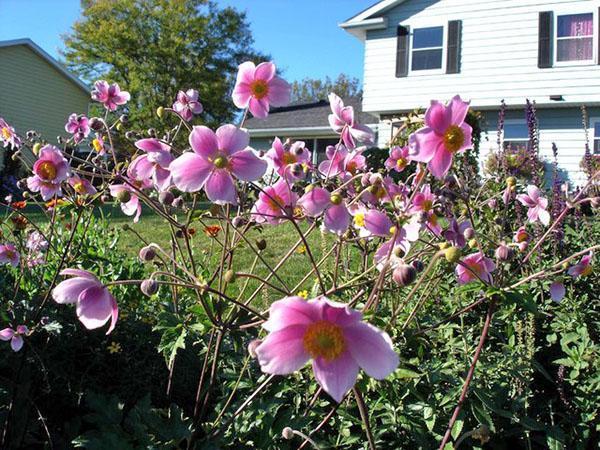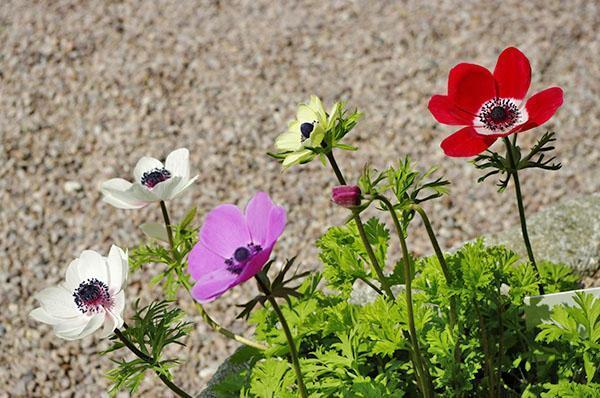Planting anemonic tubers in open ground and caring for plants
 Delicate anemone with intricately cut leaves and quivering corollas are equally good in the forest and among the most luxurious garden plants. Anemones, planting and caring in the open field for which are not as difficult as it might seem at first glance, take root well in summer cottages.
Delicate anemone with intricately cut leaves and quivering corollas are equally good in the forest and among the most luxurious garden plants. Anemones, planting and caring in the open field for which are not as difficult as it might seem at first glance, take root well in summer cottages.
The main thing is to carefully approach the choice of a suitable plant and take into account its features. In the plant world, there are more than 170 species of anemones, differing in:
- natural habitat;
- size, color and shape of flowers;
- structure;
- requirements for temperature, soil and other growing conditions.

In cold weather, plant life glimmers in tubers and thick rhizomes. They are used for planting anemones in open ground in spring or autumn.
Read: Monarda - planting and care in the open field for the winter!
Conditions for planting anemones in the open field
 According to the observations of experienced gardeners, rhizome anemones are less demanding and more winter-hardy than their large-flowered tuberous congeners. But no matter what kind the flower you like belongs to, the best place for it will be a transparent penumbra, protecting delicate petals from the scorching sun, but not blocking full access to heat and light. Once in an open area, plants bloom well, but their petals quickly discolor and fall off. In the shade, the corollas open less often and later.
According to the observations of experienced gardeners, rhizome anemones are less demanding and more winter-hardy than their large-flowered tuberous congeners. But no matter what kind the flower you like belongs to, the best place for it will be a transparent penumbra, protecting delicate petals from the scorching sun, but not blocking full access to heat and light. Once in an open area, plants bloom well, but their petals quickly discolor and fall off. In the shade, the corollas open less often and later.
All anemones thrive in moderately moist, loose soil, but they tolerate stagnant water very painfully. Planting in a neutral or slightly acidic substrate that allows air and moisture to pass through will simplify the care of anemones in the open field.
If the soil is dense, prone to caking, it is worth adding sand to it. The choice of an elevated site for planting will help reduce the risk of decay in the autumn-spring period.
When to plant anemones in the ground
 Rhizome anemones, many species of which are found in the middle lane, easily take root in the garden if they are carefully dug up and removed from the forest. Tuberous varieties tolerate winters worse, and some of them do not withstand severe subzero temperatures. Such plants are removed from the soil in the fall, and the tubers are kept cool until the heat returns.
Rhizome anemones, many species of which are found in the middle lane, easily take root in the garden if they are carefully dug up and removed from the forest. Tuberous varieties tolerate winters worse, and some of them do not withstand severe subzero temperatures. Such plants are removed from the soil in the fall, and the tubers are kept cool until the heat returns.
Planting anemones in open ground in the fall is possible only for hardy plants and in regions where flowers are guaranteed to take root and overwinter.
In the spring, when the natural growing cycle begins and there is a warm period ahead, the plants acclimatize better and faster. Rhizome anemones are propagated by root segments with multiple growth points. If there are adult plants on the site, it is more convenient to plant them before flowering, until the aboveground part has withered and the anemones are not lost among other vegetation.
When are anemones planted in the ground? The specific dates depend on the habits of the plant itself and on the climate of the region. In the southern regions, anemones are planted in open ground from April to September. The farther north, the greater the risk of spring or autumn freezing of greenery and underground parts.
 When are the dates for planting anemones:
When are the dates for planting anemones:
- the site for them is carefully dug up in advance;
- all weeds are removed from the soil, especially those that propagate by roots;
- the soil is mixed with selected humus, and spruce is necessary, then dolomite flour, which oxidizes the soil.
Wells for plants are made at intervals of 15–20 cm. To provide flowers with good conditions for development and to simplify care in the open field, planting anemones is carried out so that the growth buds are at a depth of no more than 3–5 cm from the soil surface.
Tuberous anemones are planted on a sand pillow, which helps wick away excess moisture and even in a rainy year counteracts rotting of roots and tubers.
 Fungal and bacterial rot are the main enemies of such plants, therefore, before planting, the tubers are treated with a fungicide and a root formation stimulator. In addition, if there is a spring planting, the dried tubers are soaked for 2 hours in water at room temperature, helping perennials to wake up faster. In the fall, dry planting material is planted in the ground. The soil above the plantings is compacted and watered.
Fungal and bacterial rot are the main enemies of such plants, therefore, before planting, the tubers are treated with a fungicide and a root formation stimulator. In addition, if there is a spring planting, the dried tubers are soaked for 2 hours in water at room temperature, helping perennials to wake up faster. In the fall, dry planting material is planted in the ground. The soil above the plantings is compacted and watered.
Until the plants hatch and grow stronger, they need protection. It can be peat mulch, which protects the land from drying out throughout the season and suppresses the growth of weeds.
Outdoor care for anemones after planting
 From the moment of planting, whenever it passes, anemones in the open field, as in the photo, are provided with regular care, including:
From the moment of planting, whenever it passes, anemones in the open field, as in the photo, are provided with regular care, including:
- manual, very careful weeding of the site;
- loosening the surface layer of the soil;
- protection of plants from cold winds and low temperatures.
Plants planted in spring are immediately watered moderately. And with the growth of greenery, the anemones are fed. Rhizome plants have enough mulching a mixture of peat and humus, and tuberous and large-flowered hybrid varieties should receive a more complete set, including minerals and trace elements.
To prolong flowering helps to remove faded corollas. In this case, nutrients are spent on the formation and growth of new buds.
Properly cared for rhizomatous plants grow well and even sow on their own, so they need to be thinned out and limited space available for life. They are fully suitable for planting anemones in the ground in Siberia, the Urals, in the Non-Black Earth Region, that is, where the most luxurious flowers can only be grown in a container culture.
Tuberous anemones are not so aggressive, some of them do not hibernate in the ground at all, and more frost-resistant species need careful cover with foliage, spruce branches, and non-woven material. The most delicate tubers are dried at room temperature after digging and then stored in a ventilated dry place, for example, in a basement, at a temperature of 3-5 ° C above zero. If winters allow the tubers to be kept in the soil, plantings are rejuvenated every 3-5 years.